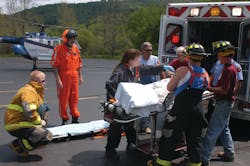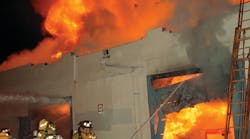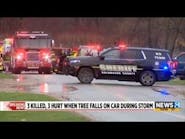20 Tough Questions For the Fire Chief: Are You Prepared To Answer Them? Question 4
This question has a hidden nuance in how it is worded. It uses the terms “acceptable” and “expect.” While we should strive to avoid answering a question with a question, this may be one of those rare exceptions because it must be established as to whose job it is to determine what is acceptable and what the expectations are.
The simple answer may appear to place the burden of making the determination into the hands of elected officials. They are, after all, ultimately responsible for setting service expectations. However, they often lack intimate and contextual knowledge of the daily operations of a fire department. This can lead them to make uninformed, superficial and arbitrary decisions about productivity expectations. This problem can be exacerbated when elected officials are pressured by budget shortfalls.
Our recommendation for dealing with this question is avoid deferring the decision to elected officials in total. Rather, we think it best to engage them in meaningful discussion about how to define first responder productivity, be that for firefighters, EMS personnel or those who provide both services. (Note: It is often difficult for elected officials and appointed administrators to comprehend the schedule and workload of paid first responders, so we will exempt staffing-on-demand models from this discussion because their contribution to financial challenges is far less impacting.)
Crew productivity
Engaging your decision makers in defining expected service levels is a key element in determining your response or deployment model. The response model – determining when, where and how personnel and apparatus are deployed – can then be directly linked to the productivity of your EMS crews. Be prepared to make connections between your response model and outcomes. For example, cities including Jersey City, Boston, MA, and Seattle, WA, have demonstrated that a focused team approach of basic life support (BLS) specialists along with advanced life support (ALS) paramedics positioned strategically throughout the region improved safe rates in cardiac arrest patients (i.e., patient returned to spontaneous circulation). The improvement was dramatic, increasing from 18% in 2005 to 46% in 2011.
The key to delivering quality care is driven by the productivity of crews; specifically, positioning crews properly during the times of highest call volumes. This type of resource staging and deployment is based on an analysis of your response system’s historical data – studying when, where and what type of EMS calls have occurred over a given period. This, combined with seasonal fluctuations and demographic changes, will reveal the best places to deploy your resources.
This defensible method to determine your deployment model accurately reflects “predictive modeling,” a term describing deployment decisions based on historical analysis of call patterns or trends. Analyzing crew assignments such as number and type of staff as well as varying work assignments to match expected call patterns can help you improve overall system performance. Employee productivity is improved with a redesign of work schedules that match supply to demand.
Tracking activity
An early step in determining the level of productivity of EMS personnel is to track crew activity, but how long to track? While it may appear burdensome to track on-duty activities for extended periods, short-term tracking may project productivity levels that are not accurate. For example, if you decide to track activity for a week, an unusually slow or busy week could skew the results.
Tracking should be hour-by-hour and personnel should list activities they were involved in each hour. It’s important that work activities not be embellished. The truth always has a way of coming to the surface and exaggerating the activity of personnel will only serve to harm the credibility of the department and its management.
The purpose of tracking is to let fire department managers look at an average workday to determine if personnel are being used in productive and efficient ways. For example, if a department has a crew dedicated to EMS response and transport and that crew responds to an average of four calls per 24-hour shift and each call last 1½ hours, the crew’s committed time to EMS emergencies is six hours per shift. Add 30 minutes for cleaning, restocking and report writing and the committed time increases to eight hours.
Other activities that consume a shift employee’s time should also be factored in. This may include one hour for training each shift, three hours for meals, one hour for physical fitness and one hour for station cleaning and maintenance. Now the employee’s committed time for all activities has increased to 14 hours.
If the employee works a 24-hour shift, this example may leave the elected official believing the EMS provider has 10 hours of unproductive time, right? Not exactly. We haven’t yet talked about the proverbial elephant in the room – sleep.
Rest is essential
Elected officials and appointed administrators don’t like the thought of paying employees to sleep on the job. Granted, sleeping is not productive time for task accomplishment. However, rest is an essential part of efficient, effective and accurate work performance.
Providing emergency services requires mental acuity, be that fire, EMS or police work. There’s no opportunity for a “do over” if something is messed up because a provider is fatigued. If elected and appointed administrators don’t like responders sleeping on the taxpayers’ dollars, the solution is to change the work schedule, not to expect responders to stay awake for extended periods while working long schedules.
How much rest time should be provided during a 24-hour shift? The exact amount of sleep a person needs varies widely, but it’s not unreasonable to allocate eight hours for rest throughout a shift. Some of that rest time may come at night and some may come during the day.
One way to track productivity is to slot each activity into one of three categories: mission critical, mission support and mission maintenance. Examples include:
• Mission critical – Timely and appropriate response to emergency calls
• Mission support – Medical reports, restocking and cleanup from a call, public education programs and training
• Mission maintenance – Station cleaning, equipment checks, physical fitness and meals
This system may be helpful toward educating elected officials in understanding that not ALL time is mission-critical time.
(From Richard B. Gasaway: I once had an elected official enter a fire station to find a paramedic sleeping in a recliner. The official was livid and demanded I suspend the employee for sleeping on the job. In his eyes there was no excuse for such “laziness” (his word, not mine). In fact, the paramedic was working a double shift due to someone calling in sick and was up, literally, all night the previous night running medical calls. I told the elected official what the medic had experienced the night before. I said I authorized the medic to rest because I wanted him fresh if there was a medical call that required him to do drug calculations. The elected official backed down, but I saw how quickly they can jump to conclusions with limited information. This elected official’s snapshot assessment of our efficiency was troublesome.)
Community service
If you’ve done the math so far, we’re up to 22 hours. There are still two hours of unproductive time left in the EMS responders’ workday. What should they be doing that is productive? We would suggest focusing on activities that advance the department’s mission and improving quality of life (from a health-and-wellness perspective) for your residents.
These activities may include installing child safety seats in vehicles, on-site blood pressure clinics, glucose screening, administering flu shots, wellness education, senior checkups, distributing medical educational materials (including how to use 911) in various languages and visiting schools to talk with children about the importance of wearing helmets and safety pads when skateboarding. The list could go on and on and may be driven some by your community’s demographic and types of calls for service.
The more time dedicated to mission critical tasks, the less time there will be for mission support and maintenance. Conversely, if less time is dedicated to mission-critical tasks, more time can be dedicated to mission support and maintenance. The goal is for all personnel to be (within reasonable expectations) active, productive, visible and advancing the mission of the department.
RICHARD B. GASAWAY, Ph.D., served 30 years in public safety, including 22 years as a chief fire officer, before retiring in 2009. He holds bachelor’s, master’s and doctor of philosophy degrees in finance, economics, business administration and leadership and is the principal consultant at the Gasaway Consulting Group. Dr. Gasaway is the host of the Leader’s Toolbox podcast radio show on Firehouse.com and runs the Situational Awareness Matters! website www.SAMatters.com. RICHARD C. KLINE has been the fire chief for the City of Plymouth, MN, since 1992 and is a senior associate at the Gasaway Consulting Group. He holds a master’s degree in public safety and is a credentialed chief fire officer through the Commission on Public Safety Excellence. Kline is the chairman of the Minnesota State Fire Chief Association’s Safety and Health Committee. The authors can be reached at: [email protected] or 612-548-4424. This series is based on the International City and County Managers Association (ICMA) program “Asking Your Police and Fire Chief the Right Questions to Get the Right Answers.”







